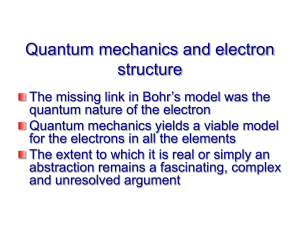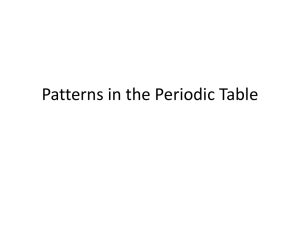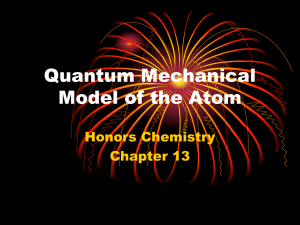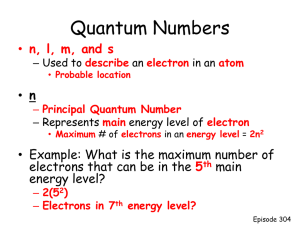Solve
advertisement
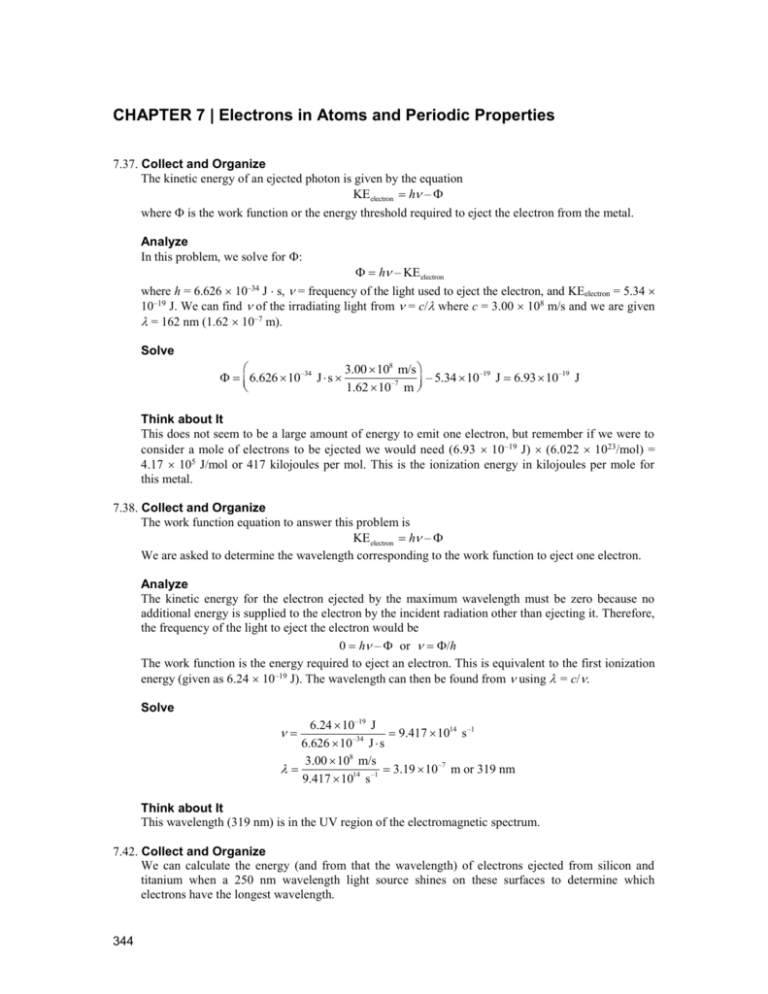
CHAPTER 7 | Electrons in Atoms and Periodic Properties 7.37. Collect and Organize The kinetic energy of an ejected photon is given by the equation KEelectron h – where is the work function or the energy threshold required to eject the electron from the metal. Analyze In this problem, we solve for : h – KEelectron where h = 6.626 10–34 J s, = frequency of the light used to eject the electron, and KEelectron = 5.34 10–19 J. We can find of the irradiating light from = c/ where c = 3.00 108 m/s and we are given = 162 nm (1.62 10–7 m). Solve 3.00 108 m/s 6.626 10–34 J s – 5.34 10–19 J 6.93 10–19 J –7 1.62 10 m Think about It This does not seem to be a large amount of energy to emit one electron, but remember if we were to consider a mole of electrons to be ejected we would need (6.93 10–19 J) (6.022 1023/mol) = 4.17 105 J/mol or 417 kilojoules per mol. This is the ionization energy in kilojoules per mole for this metal. 7.38. Collect and Organize The work function equation to answer this problem is KEelectron h – We are asked to determine the wavelength corresponding to the work function to eject one electron. Analyze The kinetic energy for the electron ejected by the maximum wavelength must be zero because no additional energy is supplied to the electron by the incident radiation other than ejecting it. Therefore, the frequency of the light to eject the electron would be 0 h – or /h The work function is the energy required to eject an electron. This is equivalent to the first ionization energy (given as 6.24 10–19 J). The wavelength can then be found from using = c/. Solve 6.24 10 –19 J 9.417 1014 s –1 6.626 10 –34 J s 3.00 108 m/s 3.19 10 –7 m or 319 nm 14 –1 9.417 10 s Think about It This wavelength (319 nm) is in the UV region of the electromagnetic spectrum. 7.42. Collect and Organize We can calculate the energy (and from that the wavelength) of electrons ejected from silicon and titanium when a 250 nm wavelength light source shines on these surfaces to determine which electrons have the longest wavelength. 344 Electrons in Atoms and Periodic Properties | 345 Analyze We are given the work functions for each of the elements (Ti = 6.94 10–19 J, Si = 7.24 10–19 J). Knowing the wavelength of the incident radiation (2.50 10–7 m), we can calculate the frequency of the incident radiation using = c/. Knowing , we can then calculate the kinetic energy of the electrons ejected from the metals using KE h – We can use the calculated kinetic energies in E = hc/ to determine the wavelengths. Solve Frequency of the incident radiation: For titanium: 3.00 108 m/s 1.20 1015 s –1 2.50 10 –7 m KE 6.626 10–34 J s 1.20 1015 s –1 – 6.94 10–19 J 1.01 10–19 J For silicon: hc 6.626 10 J s 3.00 10 m/s 1.97 10–6 m or 1970 nm E 1.01 10–19 J –34 8 KE 6.626 10 –34 J s 1.20 1015 s –1 – 7.24 10 –19 J 7.11 10 –20 J hc 6.626 10 J s 3.00 10 m/s 2.80 10–6 m or 2800 nm E 7.11 10–20 J Silicon will emit electrons with a longer wavelength than titanium. –34 8 Think about It This answer makes sense because silicon’s work function is greater; electrons ejected using the same wavelength of light will have lower (kinetic) energies and thus longer wavelengths for silicon compared to titanium. 7.55. Collect and Organize To calculate the wavelength emitted when an electron in hydrogen undergoes a transition from n = 4 to n = 3, we can use the Rydberg equation. The region of the electromagnetic spectrum corresponding to that wavelength can be found from Figure 7.1. Analyze In the Rydberg equation, n1 = 3 and n2 = 4. 1 1 [1.097 10–2 (nm) –1 ] 2 2 n1 n2 1 Solve 1 1 1 [1.097 10 –2 (nm) –1 ] 2 2 = 5.333 10 –4 (nm) –1 3 4 1875 nm This wavelength occurs in the infrared region of the electromagnetic spectrum. Think about It Notice that in the Rydberg equation, n2 is a higher orbit number (n) than n1. In this way we don’t get the nonsensical result of a negative wavelength. 7.56. Collect and Organize To calculate the frequency of light emitted from an electron that undergoes a transition from n = 5 to n = 3 we can use the Rydberg equation to calculate the wavelength of the emitted light, then convert 346 | Chapter 7 the wavelength into frequency. We can find the corresponding region of the electromagnetic spectrum from Figure 7.1. Analyze In the Rydberg equation we need to use n1 = 3 and n2 = 5: 1 1 [1.097 10–2 (nm) –1 ] 2 2 n1 n2 1 The conversion from to is given by = c/ Solve 1 1 [1.097 10 –2 (nm) –1 ] 2 2 7.801 10 –4 (nm) –1 3 5 1 = 1282 nm 3.00 108 m/s 2.34 1014 s –1 1.282 10 –6 m This transition occurs in the infrared region of the electromagnetic spectrum. Think about It When calculating frequency, don’t forget to convert nanometers to meters. 7.60. Collect and Organize Given the wavelength of a transition in hydrogen as 92.3 nm (ultraviolet region), we are to determine the nature of this transition. Analyze Figure 7.14 shows the transitions observed in a hydrogen atom. Since 92.3 nm is in the ultraviolet region, this transition is part of the Lyman series. To determine n2 we can use the following equation: 1 1 1 [1.097 10–2 (nm) –1 ] 2 2 n n 1 2 where = 92.3 nm and n1 = 1. The longest wavelength that a ground-state hydrogen atom can absorb is associated with the n = 1 to n = 2 transition. All n = 1 transitions to higher n levels (3, 4, 5, etc.) require higher energy or shorter wavelengths. Solve (a) Because this line is probably in the Lyman series, the transition is associated with the emission of light from an electron in an excited state relaxing to the ground state (n = 1). (b) Here, ni = n2. 1 1 1 [1.097 10 –2 (nm) –1 ] 2 2 92.3 nm 1 n 2 1 1 0.988 12 n22 1 0.012 n22 n2 9 (c) The longest wavelength (lowest energy) transition from the ground state (n = 1) is n = 1 to n = 2. 1 1 E 2.18 10–18 J 2 – 2 1.64 10–18 J 2 1 Electrons in Atoms and Periodic Properties | 347 Think about It Remember, long wavelengths are associated with low energy. 7.75. Collect and Organize As the principal quantum number, n, increases so too does the number of orbitals available at the n level. Analyze The number of orbitals at each level n is n2. Solve (a) For n = 1, there is only 1 orbital (an s orbital). (b) For n = 2, there are 4 orbitals (one s and three p orbitals). (c) For n = 3, there are 9 orbitals (one s, three p, and five d orbitals). (d) For n = 4, there are 16 orbitals (one s, three p, five d, and seven f orbitals). (e) For n = 5, there are 25 orbitals (one s, three p, five d, seven f, and nine g orbitals). This totals 55 orbitals in the atom. Think about It Notice that in each subshell, there is an odd number of orbitals and that the number of orbitals in a particular subshell is 2 + 1 where = 0 for s orbitals, 1 for p orbitals, 2 for d orbitals, and 3 for f orbitals. 7.76. Collect and Organize For different combinations of n, that particular orbital set. , and m we are to determine the number of orbitals in an atom for Analyze The principal quantum number, n, defines the distance from the nucleus; as n increases, the number of orbitals increases in the shell. The angular momentum quantum number, , defines the type of orbital (s, p, d, f ); the number of orbitals in each subshell is given by (2 + 1). The magnetic quantum number, m , describes the orientation of each of the orbitals in a subshell. Solve (a) When = 2, there are (2 2 + 1) = 5 orbitals (b) When = 1, there are (2 1 + 1) = 3 orbitals (c) Because only one m value is listed, this set of quantum numbers describes 1 orbital. Think about It Notice that in a there are five d orbitals and in c there are three p orbitals. This is true for every value of n. 7.80. Collect and Organize For each set of quantum numbers of n and , we are to write the orbital designation. Analyze The principal quantum number gives the shell number that is just expressed as the number. The angular momentum quantum number, however, is given a letter designation ( = 0 is an s orbital, = 1 is a p orbital, = 2 is a d orbital, and = 3 is an f orbital). Solve (a) 2p is the orbital for n = 2, (b) 5f is the orbital for n = 5, = 1. = 3. 348 | Chapter 7 (c) 3d is the orbital for n = 3, (d) 4f is the orbital for n = 4, = 2. = 3. Think about It The letter designation for the shape of the orbital provides a shorthand designation of the orbital as a number plus a letter. This is easier than describing the orbital with two numbers (n and ). 7.81. Collect and Organize Given values for the quantum numbers n, , and m , we are to determine the number of electrons that could occupy the orbitals described by these quantum numbers. Analyze The principal quantum number gives us the shell of the orbitals. This then gives the allowed values of (n – 1) which in turn describe the type of orbital (s, p, d, or f ). The m quantum number gives us the orientation of the orbital and its allowed values (– , – + 1, . . . , – 1, ), which gives us the number of orbitals available for that subshell. Each orbital can accommodate two electrons. Solve (a) The set of quantum numbers n = 2, = 0 describes a 2s orbital that can be occupied by two electrons. (b) The set of quantum numbers n = 3, = 1, m = 0 describes one of the 3p orbitals that can be occupied by two electrons. (c) The set of quantum numbers n = 4, = 2 describes the set of 4d orbitals. There are five d orbitals in the subshell so 10 electrons can occupy this orbital set. (d) The set of quantum numbers n = 1, = 0, m = 0 describes the 1s orbital that can be occupied by two electrons. Think about It Remember that there are one s, three p, five d, seven f, and nine g orbitals in shells for which these are allowed. 7.82. Collect and Organize Given values for the quantum numbers n, , and m , we are to determine the number of electrons that could occupy the orbitals described by these quantum numbers. Analyze The principal quantum number gives us the shell of the orbitals. This then gives the allowed values of (n – 1) which in turn describe the type of orbital (s, p, d, or f ). The m quantum number gives us the orientation of the orbital and its allowed values (– , – , + 1, . . . , – 1, ), which gives us the number of orbitals available for that subshell. Each orbital can accommodate two electrons. Solve (a) The set of quantum numbers n = 3, = 2 describes the 3d orbitals. There are five d orbitals in the subshell, so 10 electrons can occupy this orbital set. (b) The set of quantum numbers n = 5, = 4 describes the 5g orbitals. There are nine g orbitals ( m = –4, –3, –2, –1, 0, 1, 2, 3, 4) in the subshell, so 18 electrons can occupy this orbital set. (c) The set of quantum numbers n = 3, = 0 describes the 3s orbital that can be occupied by 2 electrons. (d) The set of quantum numbers n = 4, = 1, m = 1 describes one of the 4p orbitals that can be occupied by 2 electrons. Think about It Remember that there is one s, three p, five d, seven f, and nine g orbitals in shells for which these are allowed. And in part b we see that there are nine g orbitals. 7.83. Collect and Organize Electrons in Atoms and Periodic Properties | 349 Given values for the quantum numbers n, allowed. , m , and ms we are to determine which combinations are Analyze The principal quantum number (n) can take on whole numbers starting with 1 (n = 1, 2, 3, 4, . . . ). The angular momentum quantum numbers ( ) possible for a given n value are n – 1, n – 2, . . . , 0. The magnetic quantum numbers ( m ) allowed for a given are – , – + 1, . . . , – 1, . Allowed values for ms are + 12 or – 12 . Solve (a) For n = 1, the only allowed value of and m is 0; the combination n = 1, = 1, m = 0, ms = + 12 is not allowed because 1 for n = 1. (b) For n = 3, the allowed values of are 0, 1, 2 and when = 0 the allowed value of m is 0; this combination of n = 3, = 0, m = 0, ms = – 12 is allowed. (c) For n = 1, the only allowed value for and m is 0; the combination n = 1, = 0, m = 1, ms = – 12 is not allowed because m 1 when = 0. (d) For n = 2, the allowed values of are 0 and 1 and when = 1 the allowed value of m = –1, 0, 1; this combination of n = 2, = 1, m = 2, ms = + 12 is not allowed because m 2 when = 1. Think about It For the allowed combination of quantum numbers, part b describes a 3s orbital. 7.84. Collect and Organize Given values for the quantum numbers n, allowed. , m , and ms we are to determine which combinations are Analyze The principal quantum number (n) can take on whole numbers starting with 1 (n = 1, 2, 3, 4, . . . ). The angular momentum quantum numbers ( ) possible for a given n value are n – 1, n – 2, . . . , 0. The magnetic quantum numbers ( m ) allowed for a given are – , – + 1, . . . , – 1, . Allowed values for ms are + 12 or – 12 . Solve (a) For n = 3, the allowed values of are 2, 1, and 0 and for = 2 the allowed values of m are –2, –1, 0, 1, and 2; this combination of n = 3, = 2, m = 0, ms = – 12 is allowed. (b) For n = 5, the allowed values of are 4, 3, 2, 1, and 0 and for = 4 the allowed values of m are –4, –3, –2, –1, 0, 1, 2, 3, and 4; this combination of n = 5, = 4, m = 4, ms = + 12 is allowed. (c) For n = 3, the allowed values of are 2, 1, and 0 and for = 0 the allowed value of m is 0; because m cannot equal 1 when = 0, this combination of n = 3, = 0, m = 1, ms = + 12 is not allowed. (d) For n = 4, the allowed values of are 3, 2, 1, and 0; because cannot equal 4 for n = 4, this combination of n = 4, = 4, m = 1, ms = – 12 is not allowed. Think about It For the allowed combinations of quantum numbers, part a describes a 3d orbital and part b describes a 5g orbital. on energy of Mg would be higher still.

